2019考研英语语法解析:强调句构成及处理_毙考题
2019考研英语:长难句解析(23)_毙考题

毙考题APP2019考研英语:长难句解析(23)( 2014年真题Section ⅡReading Comprehension Part A Text 3 第5段第4句)It is fair to criticize and question the mechanism- that is the culture of research, after all-but it is the prize-givers money to do with as they please.译文:批评或质疑奖项机制是合理的,毕竟这就是科学领域的文化,但是奖项设立者是有权按照自己的意愿处理这笔钱的。
分析:本句是个复合句,包含两个由but连接的分句,两句在意思上存在转折关系。
在第一个分句中,it是形式主语,is 是系动词,fair是表语,不定式结构to criticize and question the mechanism是这个分句的真正主语。
两个破折号之间的内容是插入语,对第一个分句的内容进行补充说明。
在第二个分句中,it 是主语,is是系动词,the prize-givers money 是表语,不定式结构to do with 修饰money,as they please是方式状语从句,修饰do。
词汇指南prize[praiz](n.)战利品;奖品;奖金(adj.)得奖的(CET-4)(2012年-阅读1)(priz=pris-词根,抓、握取,e-尾缀该词从敌方所斩获的物品即战利品,引申为奖品;奖金。
后来,根据奖品;奖金又引申出了形容词词义得奖的。
)考点搭配:Pulitzer Prize 普利策奖(2012年-阅读1)考试使用毙考题,不用再报培训班邀请码:8806。
英语强调句精讲及练习(附答案)
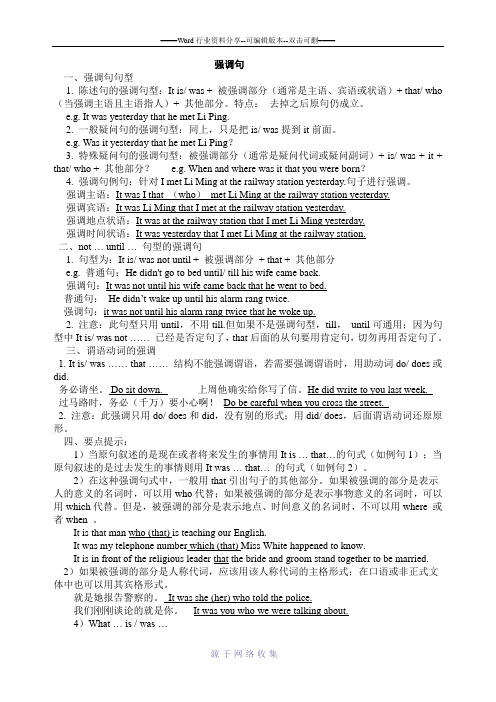
强调句一、强调句句型1. 陈述句的强调句型:It is/ was + 被强调部分(通常是主语、宾语或状语)+ that/ who (当强调主语且主语指人)+ 其他部分。
特点:去掉之后原句仍成立。
e.g. It was yesterday that he met Li Ping.2. 一般疑问句的强调句型:同上,只是把is/ was提到it前面。
e.g. Was it yesterday that he met Li Ping?3. 特殊疑问句的强调句型:被强调部分(通常是疑问代词或疑问副词)+ is/ was + it + that/ who + 其他部分? e.g. When and where was it that you were born?4. 强调句例句:针对I met Li Ming at the railway station yesterday.句子进行强调。
强调主语:It was I that (who)met Li Ming at the railway station yesterday.强调宾语:It was Li Ming that I met at the railway station yesterday.强调地点状语:It was at the railway station that I met Li Ming yesterday.强调时间状语:It was yesterday that I met Li Ming at the railway station.二、not … until … 句型的强调句1. 句型为:It is/ was not until + 被强调部分+ that + 其他部分e.g. 普通句:He didn't go to bed until/ till his wife came back.强调句:It was not until his wife came back that he went to bed.普通句:He didn’t wake up until his alarm rang twice.强调句:it was not until his alarm rang twice that he woke up.2. 注意:此句型只用until,不用till.但如果不是强调句型,till,until可通用;因为句型中It is/ was not …… 已经是否定句了,that后面的从句要用肯定句,切勿再用否定句了。
2019年考研英语真题及解析

2009年全国硕士研究生招生考试英语(一)试题Section I Use of EnglishDirections:Read the following text. Choose the best word(s) for each numbered blank and mark A, B, C or D on ANSWER SHEET 1. (10 points)Research on animal intelligence always makes us wonder just how smart humans are. 1 the fruit-fly experiments described by Carl Zimmer in the Science Times. Fruit flies who were taught to be smarter than the average fruit fly 2 to live shorter lives. This suggests that 3 bulbs burn longer, that there is a(n) 4 in not being too bright.Intelligence, it 5 , is a high-priced option. It takes more upkeep, burns more fuel and is slow 6 the starting line because it depends on learning — a(n) 7 process— instead of instinct. Plenty of other species are able to learn, and one of the things they’ve apparently learned is when to 8 .Is there an adaptive value to9 intelligence? That’s the question behind this new research. Instead of casting a wistful glance 10 at all the species we’ve left in the dust I.Q.-wise, it implicitly asks what the real 11 of our own intelligence might be. This is 12 the mind of every animal we’ve ever met.Research on animal intelligence also makes us wonder what experiments animals would 13 on humans if they had the chance. Every cat with an owner, 14 , is running a small-scale study in operant conditioning. We believe that 15 animals ran the labs, they would test us to 16 the limits of our patience, our faithfulness, our memory for locations. They would try to decide what intelligence in humans is really 17 , not merely how much of it there is. 18 , they would hope to study a(n) 19 question: Are humans actually aware of the world they live in? 20 the results are inconclusive.1.[A] Suppose [B] Consider [C] Observe [D] Imagine2.[A] tended [B] feared [C] happened [D] threatened3.[A] thinner [B] stabler [C] lighter [D] dimmer4.[A] tendency [B] advantage [C] inclination [D] priority5.[A] insists on [B] sums up [C] turns out [D] puts forward6.[A] off [B] behind [C] over [D] along7.[A] incredible [B] spontaneous [C] inevitable [D] gradual8.[A] fight [B] doubt [C] stop [D] think9.[A] invisible [B] limited [C] indefinite [D] different10.[A] upward [B] forward [C] afterward [D] backward11.[A] features [B] influences [C] results [D] costs12.[A] outside [B] on [C] by [D] across13.[A] deliver [B] carry [C] perform [D] apply14.[A] by chance [B] in contrast [C] as usual [D] for instance15.[A] if [B] unless [C] as [D] lest16.[A] moderate [B] overcome [C] determine [D] reach17.[A] at [B] for [C] after [D] with18.[A] Above all [B] After all [C] However [D] Otherwise19.[A] fundamental [B] comprehensive [C] equivalent [D] hostile20.[A] By accident [B] In time [C] So far [D] Better stillSection II Reading ComprehensionPart ADirections:Read the following four texts. Answer the questions below each text by choosing [A], [B], [C] or [D]. Mark your answers on ANSWER SHEET 1. (40 points)Text 1Habits are a funny thing. We reach for them mindlessly, setting our brains on auto-pilot and relaxing into the unconscious comfort of famili ar routine. “Not choice, but habit rules the unreflecting herd,” William Wordsworth said in the 19th century. In the ever-changing 21st century, even the word “habit” carries a negative connotation.So it seems paradoxical to talk about habits in the same contextas creativity and innovation. But brain researchers have discovered that when we consciously develop new habits, we create parallel paths, and even entirely new brain cells, that can jump our trains of thought onto new, innovative tracks.Rather than dismissing ourselves as unchangeable creatures of habit, we can instead direct our own change by consciously developing new habits. In fact, the more new things we try — the more we step outside our comfort zone — the more inherently creative we become, both in the workplace and in our personal lives.But don’t bother trying to kill off old habits; once those ruts of procedure are worn into the brain, they’re there to stay. Instead, the new habits we deliberately press into ourselves create parallel pathways that can bypass those old roads.“The first thing needed for innovation is a fascination with wonder,” says Dawna Markova, author of The Open Mind. “But we are taught instead to ‘decide,’ just as our president calls himself ‘the Decider.’ ” She adds, h owever, that “to decide is to kill off all possibilities but one. A good innovational thinker is always exploring the many other possibilities.”All of us work through problems in ways of which we’re unaware, she says. Researchers in the late 1960 discovered that humans are born with the capacity to approach challenges in four primary ways: analytically, procedurally, relationally (or collaboratively) and innovatively. At the end of adolescence, however, the brain shuts down half of that capacity, preserving only those modes of thought that have seemed most valuable during the first decade or so of life.The current emphasis on standardized testing highlights analysis and procedure, meaning that few of us inherently use our innovative and collaborative modes of thought. “This breaks the major rule in the American belief system —that anyone can do anything,” explains M. J. Ryan, author of the 2006 book This Year IWill...and Ms. Markova’s business partner. “That’s a lie that we have perpetuated, and it foste rs commonness. Knowing what you’re good at and doing even more of it creates excellence.” This is where developing new habits comes in.21. In Wordsworth’s view, “habits” is characterized by being .[A] casual[B] familiar[C] mechanical[D] changeable.22. Brain researchers have discovered that the formation of habit can be .[A] predicted[B] regulated[C] traced[D] guided23. “ruts”(Line 1, Paragraph 4) is closest in meaning to .[A] tracks[B] series[C] characteristics[D] connections24. Dawna Markova would most probably agree that .[A] ideas are born of a relaxing mind[B] innovativeness could be taught[C] decisiveness derives from fantastic ideas[D] curiosity activates creative minds25. Ryan’s comments suggest that the practice of standardized t esting[A] prevents new habits from being formed[B] no longer emphasizes commonness[C] maintains the inherent American thinking model[D] complies with the American belief systemText 2It is a wise father that knows his own child, but today a man can boost his paternal (fatherly)wisdom —or at least confirm that he’s the kid’s dad. All he needs to do is shell out $30 for paternity testing kit (PTK) at his local drugstore — and another $120 to get the results.More than 60,000 people have purchased the PTKs since theyfirst become available without prescriptions last years, according to Doug Fogg, chief operating officer of Identigene, which makes the over-the-counter kits. More than two dozen companies sell DNA tests directly to the public, ranging in price from a few hundred dollars to more than $2500.Among the most popular: paternity and kinship testing, which adopted children can use to find their biological relatives and families can use to track down kids put up for adoption. DNA testing is also the latest rage among passionate genealogists —and supports businesses that offer to search for a family’s geographic roots .Most tests require collecting cells by swabbing saliva in the mouth and sending it to the company for testing. All tests require a potential candidate with whom to compare DNA.But some observers are skeptical. “There is a kind of false precision being hawked by people claiming they are doing ancestry testing,” says Troy Duster, a New York University sociologist. He notes that each individual has many ancestors — numbering in the hundreds just a few centuries back. Yet most ancestry testing only considers a single lineage, either the Y chromosome inherited through men in a father’s line or mitochondrial DNA, which is passed down only from mothers. This DNA can reveal genetic information about only one or two ancestors, even though, for example, just three generations back people also have six other great-grandparents or, four generations back, 14 other great-great-grandparents.Critics also argue that commercial genetic testing is only as good as the reference collections to which a sample is compared. Databases used by some companies don’t rely on data collected systematically but rather lump together information from different research projects. This means that a DNA database may have a lot of data from some regions and not others, so a person’s test results may differ depending on the company that processes the results. In addition, the computer programs a company uses to estimate relationships may be patented and not subject to peer review or outside evaluation.26. In paragraphs 1 and 2, the text shows PTK’s _________.[A] easy availability[B] flexibility in pricing[C] successful promotion[D] popularity with households27. PTK is used to ________.[A] locate one’s birth place[B] promote genetic research[C] identify parent-child kinship[D] choose children for adoption28. Skeptical observers believe that ancestry testing fails to________.[A] trace distant ancestors[B] rebuild reliable bloodlines[C] fully use genetic information[D] achieve the claimed accuracy29. In the last paragraph, a problem commercial genetic testing faces is ________.[A] disorganized data collection[B] overlapping database building[C] excessive sample comparison[D] lack of patent evaluation30. An appropriate title for the text is most likely to be________.[A] Fors and Againsts of DNA Testing[B] DNA Testing and Its Problems[C] DNA Testing Outside the Lab[D] Lies Behind DNA TestingText 3The relationship between formal education and economic growth in poor countries is widely misunderstood by economists and politicians alike. Progress in both areas is undoubtedly necessary for the social, political, and intellectual development of these and all other societies; however, the conventional view that education should be one of the very highest priorities for promoting rapid economic development in poor countries is wrong. We are fortunate that it is, because building new educational systems there and putting enough people through them to improve economic performance would require two or three generations. The findings of a research institution have consistently shown that workers in all countries can be trained on the job to achieve radically higher productivity and, as a result, radically higher standards of living.Ironically, the first evidence for this idea appeared in the United States. Not long ago, with the country entering a recession and Japan at its pre-bubble peak, the U.S. workforce was derided as poorly educated and one of primary causes of the poor U.S. economic performance. Japan was, and remains, the global leader in automotive-assembly productivity. Yet the research revealed that the U.S. factories of Honda, Nissan, and Toyota achieved about 95 percent of the productivity of their Japanese counterparts — a result of the training that U.S. workers received on the job.More recently, while examing housing construction, the researchers discovered that illiterate,non-English-speaking Mexican workers in Houston, Texas, consistently met best-practice labor productivity standards despite the complexity of the building industry’s work.What is the real relationship between education and economic development? We have to suspect that continuing economi c growth promotes the development of education even when governments don’t force it. After all, that’s how education got started. When our ancestors were hunters and gatherers 10,000 years ago, they didn’t have time to wonder much about anything besides fi nding food. Only when humanity began to get its food in a more productive way was there time for other things.As education improved, humanity’s productivity potential increased as well. When the competitive environment pushed our ancestors to achieve that potential, they could in turn afford more education. This increasingly high level of education is probably a necessary, but not a sufficient, condition for the complex political systems required by advanced economic performance. Thus poor countries might not be able to escape their poverty traps without political changes that may be possible only with broader formal education.A lack of formal education, however, doesn’t constrain the ability of the developing world’s workforce tosubstantially improve productivity for the foreseeable future. On the contrary, constraints on improving productivity explain why education isn’t developing more quickly there than it is.31. The author holds in paragraph 1 that the importance of education in poor countries ___.[A] is subject to groundless doubts[B] has fallen victim of bias[C] is conventionally downgraded[D] has been overestimated32. It is stated in paragraph 1 that the construction of a new education system _______.[A] challenges economists and politicians[B] takes efforts of generations[C] demands priority from the government[D] requires sufficient labor force33. A major difference between the Japanese and U.S workforces is that _______.[A] the Japanese workforce is better disciplined[B] the Japanese workforce is more productive[C] the U.S workforce has a better education[D] the U.S workforce is more organize34. The author quotes the example of our ancestors to show that education emerged ______.[A] when people had enough time[B] prior to better ways of finding food[C] when people on longer went hungry[D] as a result of pressure on government35. According to the last paragraph, development of education ________.[A] results directly from competitive environments[B] does not depend on economic performance[C] follows improved productivity[D] cannot afford political changesText 4The most thoroughly studied intellectuals in the history of the new world are the ministers and political leaders of seventeenth-century New England. According to the standard history of American philosophy, nowhere else in colonial America was “so much importance attached to intellectual pursuits.” According to many books and articles, New England’s leaders established the basic themes and preoccupations of an unfolding, dominant Puritan tradition in American intellectual life.To take this approach to the New Englanders normally means to start with the Puritans’ theological innovations and their distinctive ideas about the church-important subjects that we may not neglect. But in keeping with our examination of southern intellectual life, we may consider the original Puritans as carriers ofEuropean culture, adjusting to New World circumstances. The New England colonies were the scenes of important episodes in the pursuit of widely understood ideals of civility and virtuosity.The early settlers of Massachusetts Bay included men of impressive education and influence in England. Besides the ninety or so learned ministers who came to Massachusetts churches in the decade after 1629, there were political leaders like John Winthrop, an educated gentleman, lawyer, and official of the Crown before he journeyed to Boston. These men wrote and published extensively, reaching both New World and Old World audiences, and giving New England an atmosphere of intellectual earnestness.We should not forget, however, that most New Englanders were less well educated. While few crafts men or farmers, let alone dependents and servants, left literary compositions to be analyzed, their thinking often had a traditional superstitious quality. A tailor named John Dane, who emigrated in the late 1630s, left an account of his reasons for leaving England that is filled with signs. Sexual confusion, economic frustrations, and religious hope-all name together in a decisive moment when he opened the Bible, told his father that the first line he saw would settle his fate, and read the magical words: “Come out from among them, touch no unclean thing, and I will be your God and you shall be my people.” One won ders what Dane thought of the careful sermons explaining the Bible that he heard in Puritan churches.Meanwhile, many settles had slighter religious commitments than Dane’s, as one clergyman learned in confronting folk along the coast who mocked that they had not come to the New World for religion. “Our main end was to catch fish.”36. The author notes that in the seventeenth-century New England_________.[A] Puritan tradition dominated political life[B] intellectual interests were encouraged[C] Politics benefited much from intellectual endeavors[D] intellectual pursuits enjoyed a liberal environment37. It is suggested in paragraph 2 that New Englanders________.[A] experienced a comparatively peaceful early history[B] brought with them the culture of the Old World[C] paid little attention to southern intellectual life[D] were obsessed with religious innovations38. The early ministers and political leaders in Massachusetts Bay________.[A] were famous in the New World for their writings[B] gained increasing importance in religious affairs[C] abandoned high positions before coming to the New World[D] created a new intellectual atmosphere in New England39. The story of John Dane shows that less well-educated NewEnglanders were often _____.[A] influenced by superstitions[B] troubled with religious beliefs[C] puzzled by church sermons[D] frustrated with family earnings40. The text suggests that early settlers in New England________.[A] were mostly engaged in political activities[B] were motivated by an illusory prospect[C] came from different intellectual backgrounds[D] left few formal records for later referencePart BDirections:In the following text, some segments have been removed. For Questions 41-45, choose the most suitable one from the list A-G to fit into each of the numbered blanks. There are two extra choices, which do not fit in any of the blanks.Mark your answers on ANSWER SHEET 1. (10 points)Coinciding with the groundbreaking theory of biological evolution proposed by British naturalist Charles Darwin in the 1860s, British social philosopher Herbert Spencer put forward his own theory of biological and cultural evolution. Spencer argued that all worldly phenomena, including human societies, changed over time, advancing toward perfection. 41) ____________.American social scientist Lewis Henry Morgan introduced another theory of cultural evolution in the late 1800s. Morgan helped found modern anthropology—the scientific study of human societies, customs and beliefs—thus becoming one of the earliest anthropologists. In his work, he attempted to show how all aspects of culture changed together in the evolution of societies.42) _____________.In the early 1900s in North America, German-born American anthropologist Franz Boasdeveloped a new theory of culture known as historical particularism. Historical particularism, which emphasized the uniqueness of all cultures, gave new direction to anthropology. 43) _____________ .Boas felt that the culture of any society must be understood as the result of a unique history and not as one of many cultures belonging to a broader evolutionary stage or type of culture. 44) _______________. Historical particularism became a dominant approach to the study of culture in American anthropology, largely through the influence of many students of Boas. But a number of anthropologists in the early 1900s also rejected the particularist theory of culture in favor of diffusionism. Some attributed virtually every important cultural achievement to the inventions of a few, especially gifted peoples that, according to diffusionists, then spread to other cultures. 45) ________________.Also in the early 1900s, French sociologist Émile Durkheimdeveloped a theory of culture that would greatly influence anthropology. Durkheim proposed that religious beliefs functioned to reinforce social solidarity. An interest in the relationship between the function ofsociety and culture became a major theme in European, and especially British, anthropology.[A] Other anthropologists believed that cultural innovations, such as inventions, had a single origin and passed from society to society. This theory was known as diffusionism.[B] In order to study particular cultures as completely as possible, he became skilled in linguistics, the study of languages, and in physical anthropology, the study of human biology and anatomy.[C] He argued that human evolution was characterized by a struggle he called the “survival of the fittest,” in which weaker races and societies must eventually be replaced by stronger, more advanced races and societies.[D] They also focused on important rituals that appeared to preserve a people’s social structure, such as initiation ceremonies that formally signify children’s entrance into adulthood.[E] Thus, in his view, diverse aspects of culture, such as the structure of families, forms of marriage, categories of kinship, ownership of property, forms of government, technology, and systems of food production, all changed as societies evolved.[F]Supporters of the theory viewed culture as a collection of integrated parts that work together to keep a society functioning.[G] For example, British anthropologists Grafton Elliot Smith and W. J. Perry incorrectly suggested, on the basis of inadequate information, that farming, pottery making, and metallurgy all originated in ancient Egypt and diffused throughout the world. In fact, all of these cultural developments occurred separately at different times in many parts of the world.Part CDirections:Read the following text carefully and then translate the underlined segments into Chinese. Your translation should be written carefully on ANSWER SHEET 2. (10 points)There is a marked difference between the education which every one gets from living with others, and the deliberate educating of the young. In the former case the education is incidental; it is natural andimportant, but it is not the express reason of the association. (46)It may be said that the measure of the worth of any social institution is its effect in enlarging and improving experience, but this effect is not a part of its original motive. Religious associations began, for example, in the desire to secure the favor of overruling powers and to ward off evil influences; family life in the desire to gratify appetites and secure family perpetuity; systematic labor, for the most part, because of enslavement to others, etc. (47) Only gradually was the by-product of the institution noted, and only more gradually still was this effect considered as a directive factor in the conduct of the institution. Even today, in our industrial life, apart from certain values of industriousness and thrift, the intellectual and emotional reaction of the forms of human association under which the world's work is carried on receives little attention as compared with physical output.But in dealing with the young, the fact of association itself as an immediate human fact, gains in importance.(48) While it is easy to ignore in our contact with them the effect of our acts upon their disposition, it is not so easy as in dealing with adults. The need of training is too evident and the pressure to accomplish a change in theirattitude and habits is too urgent to leave these consequences wholly out of account. (49)Since our chief business with them is to enable them to share in a commonlife we cannot help considering whether or not we are forming the powers which will secure this ability. If humanity has made some headway in realizing that the ultimate value of every institution is its distinctively human effect we may well believe that this lesson has been learned largely through dealings with the young.(50) We are thus led to distinguish, within the broad educational process which we have been so far considering, a more formal kind of education—that of direct tuition or schooling.In undeveloped social groups, we find very little formal teaching and training. These groups mainly rely for instilling needed dispositions into the young upon the same sort of association which keeps adults loyal to their group.SectionⅢWritingPart A51.Directions:Restrictions on the use of plastic bags have not been so successful in some regions. “White Pollution” is still going on.Write a letter to the editor(s) of your local newspaper to1) give your opinions briefly, and2) make two or three suggestionsYou should write about 100 words on ANSWER SHEET 2. Do not sign your own name at the end of the letter. Use “Li Ming” instead. Do not write the address. (10 points)Part B52. Directions:Write an essay of 160-200 words based on the following drawing. In your essay, you should1) describe the drawing briefly,2) explain its intended meaning, and then3) give your comments.You should write neatly on ANSHWER SHEET 2. (20 points)网络的“近”与“远”2009年全国硕士研究生招生考试英语(一)答案详解Section I Use of English一、文章总体分析本文是一个有关动物智力话题的文章。
2019考研英语:长难句解析(4)_毙考题

毙考题APP
2019考研英语:长难句解析(4)
( 2015年真题Section ⅡReading Comprehension Part A Text2 第5段第3句)
Citizens still have a right to expect private documents to remain private and protected by the Constitution s prohibition on unreasonable searches.
译文:公民仍有权要求私人文件保持私密性,并受到宪法禁止不合理搜查私人文件的法令的保护。
分析:本句的主干为Citizens(主语)+ still have(谓语)+ a right (宾语)。
不定式结构to expect searches是修饰right的后置定语。
介词短语by searches做状语。
词汇指南
document [ dɔkjumənt](n.)公文,文件;文献(v.)记载(高考词汇)(2005年-阅读4)(doc=dic-词根,说,讲,u-连字符,ment-名词后缀;影射ɡovernment-政府政府所说的话即公文,文件,引申为文献。
)
考试使用毙考题,不用再报培训班
邀请码:8806。
2019考研英语:长难句解析(83)_毙考题
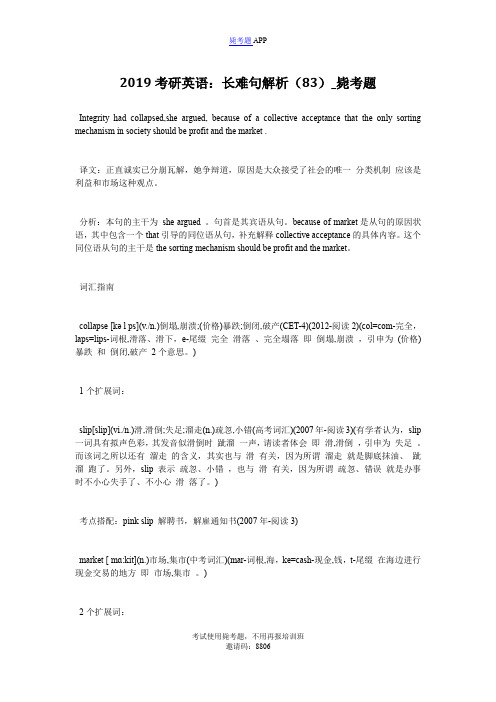
2019考研英语:长难句解析(83)_毙考题Integrity had collapsed,she argued, because of a collective acceptance that the only sorting mechanism in society should be profit and the market .译文:正直诚实已分崩瓦解,她争辩道,原因是大众接受了社会的唯一分类机制应该是利益和市场这种观点。
分析:本句的主干为she argued 。
句首是其宾语从句。
because of market是从句的原因状语,其中包含一个that引导的同位语从句,补充解释collective acceptance的具体内容。
这个同位语从句的主干是the sorting mechanism should be profit and the market。
词汇指南collapse [kə l ps](v./n.)倒塌,崩溃;(价格)暴跌;倒闭,破产(CET-4)(2012-阅读2)(col=com-完全,laps=lips-词根,滑落、滑下,e-尾缀完全滑落、完全塌落即倒塌,崩溃,引申为(价格)暴跌和倒闭,破产2个意思。
)1个扩展词:slip[slip](vi./n.)滑,滑倒;失足;溜走(n.)疏忽,小错(高考词汇)(2007年-阅读3)(有学者认为,slip 一词具有拟声色彩,其发音似滑倒时跐溜一声,请读者体会即滑,滑倒,引申为失足。
而该词之所以还有溜走的含义,其实也与滑有关,因为所谓溜走就是脚底抹油、跐溜跑了。
另外,slip表示疏忽、小错,也与滑有关,因为所谓疏忽、错误就是办事时不小心失手了、不小心滑落了。
)考点搭配:pink slip 解聘书,解雇通知书(2007年-阅读3)market [ mɑ:kit](n.)市场,集市(中考词汇)(mar-词根,海,ke=cash-现金,钱,t-尾缀在海边进行现金交易的地方即市场,集市。
2019考研英语语法解析:it 用于强调结构_毙考题_0
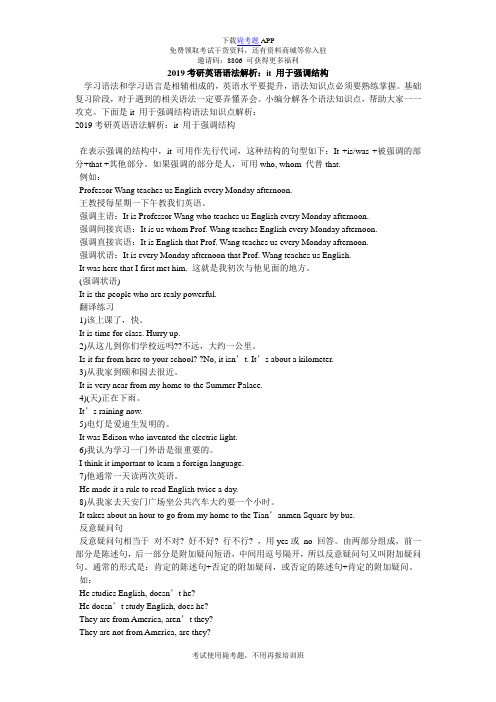
2019考研英语语法解析:it 用于强调结构学习语法和学习语言是相辅相成的,英语水平要提升,语法知识点必须要熟练掌握。
基础复习阶段,对于遇到的相关语法一定要弄懂弄会。
小编分解各个语法知识点,帮助大家一一攻克。
下面是it 用于强调结构语法知识点解析:2019考研英语语法解析:it 用于强调结构在表示强调的结构中,it 可用作先行代词,这种结构的句型如下:It +is/was +被强调的部分+that +其他部分。
如果强调的部分是人,可用who, whom 代替that.例如:Professor Wang teaches us English every Monday afternoon.王教授每星期一下午教我们英语。
强调主语:It is Professor Wang who teaches us English every Monday afternoon.强调间接宾语:It is us whom Prof. Wang teaches English every Monday afternoon.强调直接宾语:It is English that Prof. Wang teaches us every Monday afternoon.强调状语:It is every Monday afternoon that Prof. Wang teaches us English.It was here that I first met him. 这就是我初次与他见面的地方。
(强调状语)It is the people who are realy powerful.翻译练习1)该上课了,快。
It is time for class. Hurry up.2)从这儿到你们学校远吗??不远,大约一公里。
Is it far from here to your school? ?No, it isn’t. It’s about a kilometer.3)从我家到颐和园去很近。
2019考研英语语法解析:定语从句_毙考题
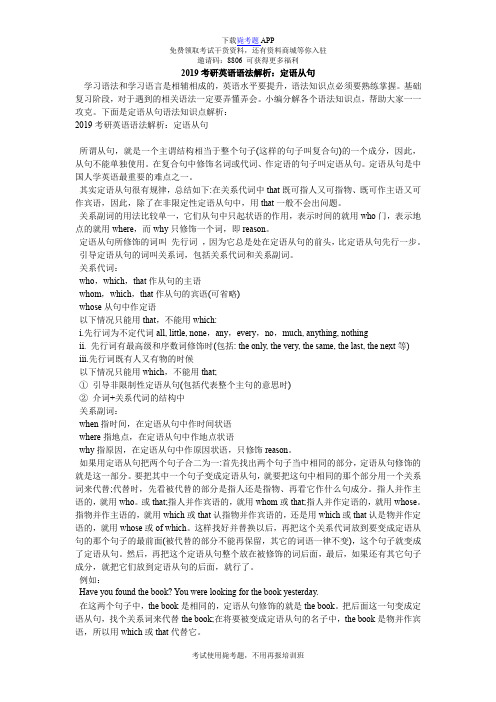
2019考研英语语法解析:定语从句学习语法和学习语言是相辅相成的,英语水平要提升,语法知识点必须要熟练掌握。
基础复习阶段,对于遇到的相关语法一定要弄懂弄会。
小编分解各个语法知识点,帮助大家一一攻克。
下面是定语从句语法知识点解析:2019考研英语语法解析:定语从句所谓从句,就是一个主谓结构相当于整个句子(这样的句子叫复合句)的一个成分,因此,从句不能单独使用。
在复合句中修饰名词或代词、作定语的句子叫定语从句。
定语从句是中国人学英语最重要的难点之一。
其实定语从句很有规律,总结如下:在关系代词中that既可指人又可指物、既可作主语又可作宾语,因此,除了在非限定性定语从句中,用that一般不会出问题。
关系副词的用法比较单一,它们从句中只起状语的作用,表示时间的就用who门,表示地点的就用where,而why只修饰一个词,即reason。
定语从句所修饰的词叫先行词,因为它总是处在定语从句的前头,比定语从句先行一步。
引导定语从句的词叫关系词,包括关系代词和关系副词。
关系代词:who,which,that作从句的主语whom,which,that作从句的宾语(可省略)whose从句中作定语以下情况只能用that,不能用which:i.先行词为不定代词all, little, none,any,every,no,much, anything, nothingii. 先行词有最高级和序数词修饰时(包括: the only, the very, the same, the last, the next等) iii.先行词既有人又有物的时候以下情况只能用which,不能用that;①引导非限制性定语从句(包括代表整个主句的意思时)②介词+关系代词的结构中关系副词:when指时间,在定语从句中作时间状语where指地点,在定语从句中作地点状语why指原因,在定语从句中作原因状语,只修饰reason。
如果用定语从句把两个句子合二为一:首先找出两个句子当中相同的部分,定语从句修饰的就是这一部分。
2019年考研英语阅读真题解析3(英语学习).doc

2019年考研英语阅读真题解析3(英语学习)考研英语真题对我们掌握考点至关重要,下面为大家整理了考研英语阅读真题解析,希望可以为大家带来帮助!It is the playgoers, the RSC contends, who bring in much of the town’s revenue because they spend the主语插入语谓语宾语night (some of them four or five nights) pouring cash into the hotels and restaurants.原因状语从句译文:皇家莎士比亚剧团声称,为小镇带来大量收入的是那些来看戏的人,因为他们会在当地过夜(有些甚至会住四五个晚上),因此会把大把的钱花在酒店和饭店中。
分析:本句使用了强调句型It is…who…,强调的是主语the playgoers,因此本句的主干其实是…the playgoers…bring in much of the town’s revenue…。
because引导的原因状语从句说明前面主句发生的原因;该从句的主干是they spend the night…,此处包含了固定句型spend(some time)doing sth.。
【词汇解析】contend [kən’tend](vi.)竞争,争夺(vt.)坚决主张,声称(CET-6、考研词汇)(2006年-阅读2、2012年-阅读1)(con-共同,一起,tend-词根,伸展,延伸→ (在赛场上)所有人都“伸向”同一个目标、都渴望能够摘取到冠军头衔——即“竞争,争夺”,后引申为“坚决主张,声称”;因为所谓“坚决主张、声称”就是“伸出”手臂、奋力高呼,也与“词根tend-伸展”有关。
)revenue [’revinju:](n.(国家)岁入,财政收入; (大宗)收益(CET-6、考研词汇)(2006年-阅读2)(re-回,反,ven=vent-词根,来,ue-尾缀→ 返回到国库里面的东西——即“(国家)岁入,财政收入”,引申为“(大宗)收益”。
2019考研英语语法解析:强调非谓语句_毙考题
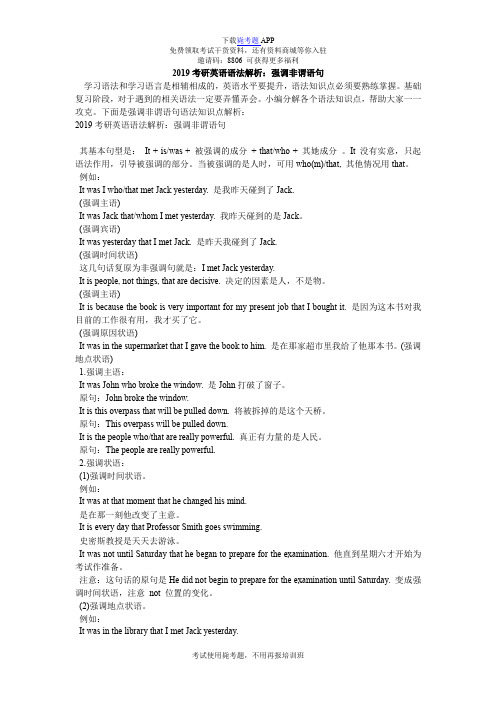
2019考研英语语法解析:强调非谓语句学习语法和学习语言是相辅相成的,英语水平要提升,语法知识点必须要熟练掌握。
基础复习阶段,对于遇到的相关语法一定要弄懂弄会。
小编分解各个语法知识点,帮助大家一一攻克。
下面是强调非谓语句语法知识点解析:2019考研英语语法解析:强调非谓语句其基本句型是:It + is/was + 被强调的成分+ that/who + 其她成分。
It 没有实意,只起语法作用,引导被强调的部分。
当被强调的是人时,可用who(m)/that, 其他情况用that。
例如:It was I who/that met Jack yesterday. 是我昨天碰到了Jack.(强调主语)It was Jack that/whom I met yesterday. 我昨天碰到的是Jack。
(强调宾语)It was yesterday that I met Jack. 是昨天我碰到了Jack.(强调时间状语)这几句话复原为非强调句就是:I met Jack yesterday.It is people, not things, that are decisive. 决定的因素是人,不是物。
(强调主语)It is because the book is very important for my present job that I bought it. 是因为这本书对我目前的工作很有用,我才买了它。
(强调原因状语)It was in the supermarket that I gave the book to him. 是在那家超市里我给了他那本书。
(强调地点状语)1.强调主语:It was John who broke the window. 是John打破了窗子。
原句:John broke the window.It is this overpass that will be pulled down. 将被拆掉的是这个天桥。
2019考研英语:长难句解析(52)_毙考题
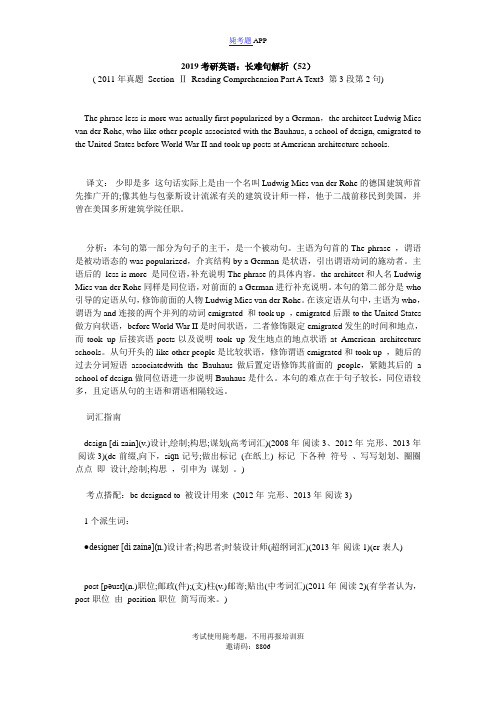
毙考题APP2019考研英语:长难句解析(52)( 2011年真题Section ⅡReading Comprehension Part A Text3 第3段第2句)The phrase less is more was actually first popularized by a German,the architect Ludwig Mies van der Rohe, who like other people associated with the Bauhaus, a school of design, emigrated to the United States before World War II and took up posts at American architecture schools.译文:少即是多这句话实际上是由一个名叫Ludwig Mies van der Rohe的德国建筑师首先推广开的;像其他与包豪斯设计流派有关的建筑设计师一样,他于二战前移民到美国,并曾在美国多所建筑学院任职。
分析:本句的第一部分为句子的主干,是一个被动句。
主语为句首的The phrase ,谓语是被动语态的was popularized,介宾结构by a German是状语,引出谓语动词的施动者。
主语后的less is more 是同位语,补充说明The phrase的具体内容。
the architect和人名Ludwig Mies van der Rohe同样是同位语,对前面的a German进行补充说明。
本句的第二部分是who 引导的定语从句,修饰前面的人物Ludwig Mies van der Rohe。
在该定语从句中,主语为who,谓语为and连接的两个并列的动词emigrated 和took up ,emigrated后跟to the United States 做方向状语,before World War II是时间状语,二者修饰限定emigrated发生的时间和地点,而took up后接宾语posts以及说明took up发生地点的地点状语at American architecture schools。
2019考研英语:长难句解析(72)_毙考题
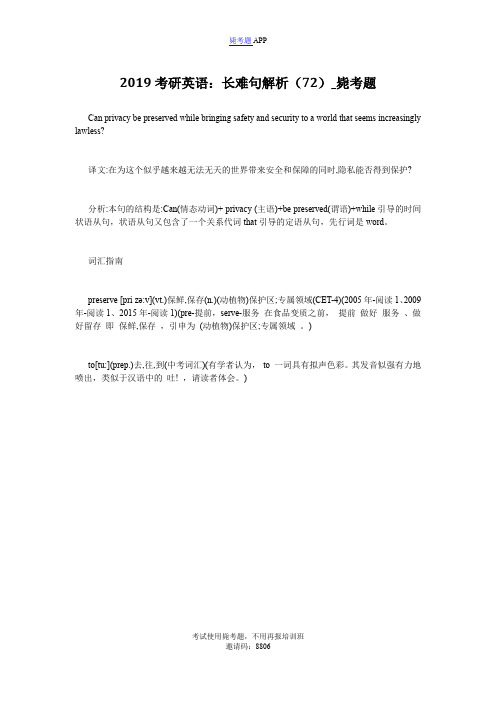
毙考题APP
2019考研英语:长难句解析(72)_毙考题
Can privacy be preserved while bringing safety and security to a world that seems increasingly lawless?
译文:在为这个似乎越来越无法无天的世界带来安全和保障的同时,隐私能否得到保护?
分析:本句的结构是:Can(情态动词)+ privacy (主语)+be preserved(谓语)+while引导的时间状语从句,状语从句又包含了一个关系代词that引导的定语从句,先行词是word。
词汇指南
preserve [pri zə:v](vt.)保鲜,保存(n.)(动植物)保护区;专属领域(CET-4)(2005年-阅读1、2009年-阅读1、2015年-阅读1)(pre-提前,serve-服务在食品变质之前,提前做好服务、做好留存即保鲜,保存,引申为(动植物)保护区;专属领域。
)
to[tu:](prep.)去,往,到(中考词汇)(有学者认为,to 一词具有拟声色彩。
其发音似强有力地喷出,类似于汉语中的吐! ,请读者体会。
)
考试使用毙考题,不用再报培训班
邀请码:8806。
【考研英语】基础语法强调句非谓语:主语、宾语、状语

【考研英语】基础语法强调句非谓语:主语、宾语、状语强调句:英语的强调主要有两种:一是强调非谓语(包括主语、宾语、状语等);二是强调谓语动词。
(一)强调非谓语其基本句型是:“It + is/was + 被强调的成分 + that/who + 其她成分”。
It 没有实意,只起语法作用,引导被强调的部分。
当被强调的是人时,可用who(m)/that, 其他情况用that。
例如:It was I who/that met Jack yesterday. 是我昨天碰到了Jack.(强调主语)It was Jack that/whom I met yesterday. 我昨天碰到的是Jack。
(强调宾语)It was yesterday that I met Jack. 是昨天我碰到了Jack.(强调时间状语)这几句话复原为非强调句就是:I met Jack yesterday.It is people, not things, that are decisive. 决定的因素是人,不是物。
(强调主语)It is because the book is very important for my present job that I bought it. 是因为这本书对我目前的工作很有用,我才买了它。
(强调原因状语)It was in the supermarket that I gave the book to him. 是在那家超市里我给了他那本书。
(强调地点状语)1、强调主语:It was John who broke the window. 是John打破了窗子。
原句:John broke the window.It is this overpass that will be pulled down. 将被拆掉的是这个天桥。
原句:This overpass will be pulled down.It is the people who/that are really powerful. 真正有力量的是人民。
2019年考研英语语法小讲:强调句构成及处理
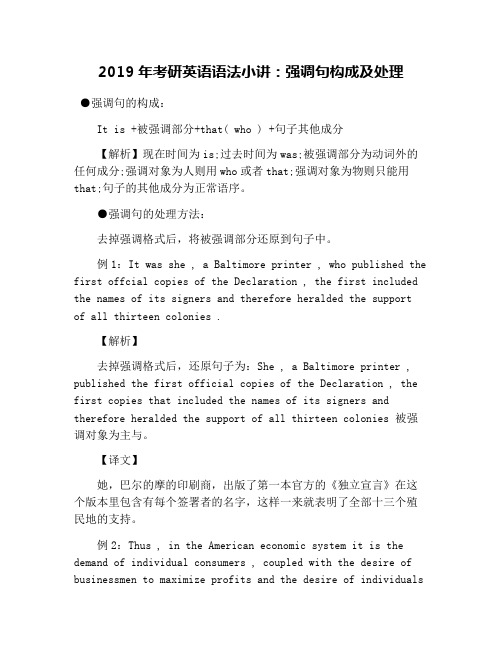
2019年考研英语语法小讲:强调句构成及处理●强调句的构成:It is +被强调部分+that( who ) +句子其他成分【解析】现在时间为is;过去时间为was;被强调部分为动词外的任何成分;强调对象为人则用who或者that;强调对象为物则只能用that;句子的其他成分为正常语序。
●强调句的处理方法:去掉强调格式后,将被强调部分还原到句子中。
例1:It was she , a Baltimore printer , who published the first offcial copies of the Declaration , the first included the names of its signers and therefore heralded the supportof all thirteen colonies .【解析】去掉强调格式后,还原句子为:She , a Baltimore printer , published the first official copies of the Declaration , the first copies that included the names of its signers and therefore heralded the support of all thirteen colonies 被强调对象为主与。
【译文】她,巴尔的摩的印刷商,出版了第一本官方的《独立宣言》在这个版本里包含有每个签署者的名字,这样一来就表明了全部十三个殖民地的支持。
例2:Thus , in the American economic system it is the demand of individual consumers , coupled with the desire of businessmen to maximize profits and the desire of individualsto maximize their incomes , that together determine whatshall be produced and how resources are used to produce it .【解析】去掉强调格式以后,句子还原为:Thus , in the American economic system ,the system , the demand of individual consumers , coupled with the desirs of businessmen to maximize profits and the desire of individuals to maximize their incomes , together determine what shall be produced and how resources are used to produce it .被强调对象为主语。
考研英语语法强调句解析

考研英语语法强调句解析一、在谓语动词前加助动词do,did,does强调该谓语动词,构成强调句例句:The president of the National Academy,Bruce Alberts,added this key point in the preface to the panel s report “Science never has all the answers. But science does provide us with the best available guide to the future,and it is critical that our nation and the world base important policies on the best judgments that science can provide concerning the future consequences of present actions. ”(选自2005年Text 2)分析:引号内由两个句子组成,but前一分句是一个简单句,后一分句为两个并列句,其中第一个分句中的does表强调,第二个并列句为一复合句,真正的主语为that our nation and the world base important policies on...,it为形式主语,定语从句that science can provide concerning the future...修饰judgment。
译文:国家科学院院长布鲁斯·艾伯茨在会议报告的前言中补充和强调了这一点,即科学解答不了所有的问题,但科学的确能给我们提供将来可行的最好的指导,关键是我们国家和其他各国在做重要决策时应该以科学能够提供给我们的、对于人类现在的行为对未来影响的最好的判断作为依据。
二、强调句中谓语以外的其他成分时用强调句型(见词类中it用法)例句:Often it s the delivery that causes the audience to smile,so speak slowly and remember that a raised eyebrow or an unbelieving look may help to show that you are making a lighthearted remark. (选自2002年Text 1)分析:该句是复合句,主句it s the delivery that causes the audience to smile是一个强调句,that a raised eyebrow or an unbelieving look和that you are making a light hearted remark 分别作remember以及show的宾语,light hearted是一个复合形容词修饰remark。
2019考研英语语法解析:代词_毙考题

2019考研英语语法解析:代词学习语法和学习语言是相辅相成的,英语水平要提升,语法知识点必须要熟练掌握。
基础复习阶段,对于遇到的相关语法一定要弄懂弄会。
小编分解各个语法知识点,帮助大家一一攻克。
下面是代词语法知识点解析:2019考研英语语法解析:代词一、人称代词(一)人称代词的主格、宾格人称代词的主格在句中作主语、表语,宾格作及物动词或介词的宾语,主格和宾格不可混用。
例句:When school was over,Jack and me went home together.分析:me应改为I,因为它处在主语的位置上。
例句:Each cigarette which a person smokes does some harm, and eventually he may get a serious disease from its effect. (1996年第14题)分析:该句是复合句,其中which a person smokes是修饰each cigarette的定语从句,he 指代前面的a person。
译文:一个人吸的每一支烟都对他的身体有害,最终他将因吸烟患上一种严重的疾病。
(二)it的用法1. 代替除人以外的一切生物或事物(可代替单个词、词组或句子)。
例句:The ideal listener stays both inside and outside the music at the moment it is played and enjoys it almost as much as the composer at the moment he composes. (2000年第19题)分析:该句是复合句,其中he composes是省略了关系代词which/that的定语从句,修饰the moment, 而almost as much as the composer作状语修饰enjoys。
2019考研攻克英语长难句:强调句型结构分析
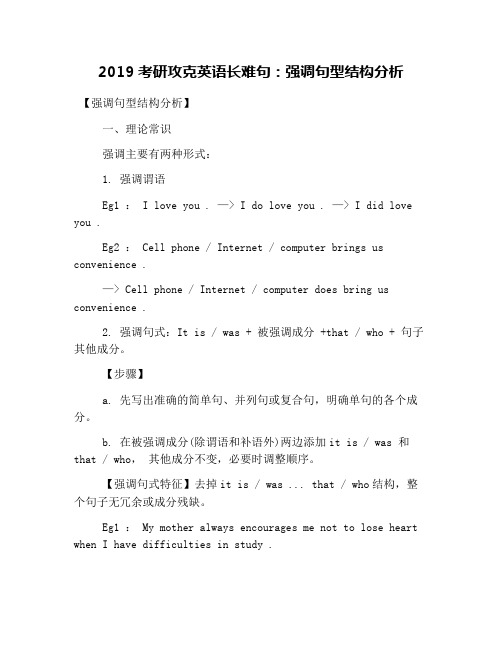
2019考研攻克英语长难句:强调句型结构分析【强调句型结构分析】一、理论常识强调主要有两种形式:1. 强调谓语Eg1 : I love you . —> I do love you . —> I did love you .Eg2 : Cell phone / Internet / computer brings us convenience .—> Cell phone / Internet / computer does bring us convenience .2. 强调句式:It is / was + 被强调成分 +that / who + 句子其他成分。
【步骤】a. 先写出准确的简单句、并列句或复合句,明确单句的各个成分。
b. 在被强调成分(除谓语和补语外)两边添加it is / was 和that / who,其他成分不变,必要时调整顺序。
【强调句式特征】去掉it is / was ... that / who结构,整个句子无冗余或成分残缺。
Eg1 : My mother always encourages me not to lose heart when I have difficulties in study .—> It is my mother who / that always encourages me not to lose heart when I have difficulties in study .—> It is when I have difficulties in study that my mother always encourages me not to lose heart .二、真题举例Thus , in the American economic system it is the demand of individual consumers , coupled with the desire of businessmen to maximize profits and the desire of individuals to maximize their incomes that together determine what shall be produced and how resources are used to produce it .【重点词汇解析】couple with 与……相结合;maximize,v. 取……值、达到值【参考翻译】所以,在美国的经济体系中,个体消费者的需求与商人试图化其利润的欲望和个人想化其收入效用的欲望相结合,一起决定了什么应该被制造,以及资源如何被用来制造它们。
英语强调句精讲及学习练习附答案
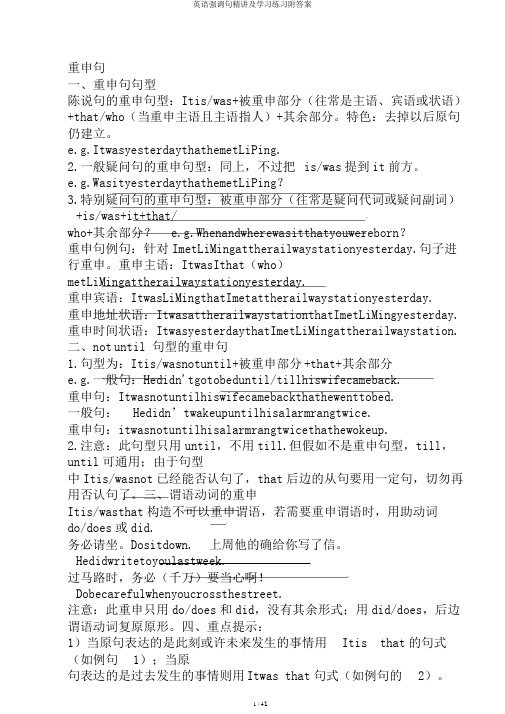
重申句一、重申句句型陈说句的重申句型:Itis/was+被重申部分(往常是主语、宾语或状语)+that/who(当重申主语且主语指人)+其余部分。
特色:去掉以后原句仍建立。
e.g.ItwasyesterdaythathemetLiPing.2.一般疑问句的重申句型:同上,不过把is/was提到it前方。
e.g.WasityesterdaythathemetLiPing?3.特别疑问句的重申句型:被重申部分(往常是疑问代词或疑问副词)+is/was+it+that/who+其余部分? e.g.Whenandwherewasitthatyouwereborn?重申句例句:针对ImetLiMingattherailwaystationyesterday.句子进行重申。
重申主语:ItwasIthat(who)metLiMingattherailwaystationyesterday.重申宾语:ItwasLiMingthatImetattherailwaystationyesterday.重申地址状语:ItwasattherailwaystationthatImetLiMingyesterday. 重申时间状语:ItwasyesterdaythatImetLiMingattherailwaystation.二、not until 句型的重申句1.句型为:Itis/wasnotuntil+被重申部分+that+其余部分e.g.一般句:Hedidn'tgotobeduntil/tillhiswifecameback.重申句:Itwasnotuntilhiswifecamebackthathewenttobed.一般句:Hedidn’twakeupuntilhisalarmrangt wice.重申句:itwasnotuntilhisalarmrangtwicethathewokeup.2.注意:此句型只用until,不用till.但假如不是重申句型,till,until可通用;由于句型中Itis/wasnot已经能否认句了,that后边的从句要用一定句,切勿再用否认句了。
- 1、下载文档前请自行甄别文档内容的完整性,平台不提供额外的编辑、内容补充、找答案等附加服务。
- 2、"仅部分预览"的文档,不可在线预览部分如存在完整性等问题,可反馈申请退款(可完整预览的文档不适用该条件!)。
- 3、如文档侵犯您的权益,请联系客服反馈,我们会尽快为您处理(人工客服工作时间:9:00-18:30)。
下载毙考题APP
免费领取考试干货资料,还有资料商城等你入驻
邀请码:8806 可获得更多福利
2019考研英语语法解析:强调句构成及处理
学习语法和学习语言是相辅相成的,英语水平要提升,语法知识点必须要熟练掌握。
基础复习阶段,对于遇到的相关语法一定要弄懂弄会。
小编分解各个语法知识点,帮助大家一一攻克。
下面是强调句构成及处理的语法知识点解析:
2019考研英语语法解析:强调句构成及处理
●强调句的构成:
It is +被强调部分+that( who ) +句子其他成分
【解析】现在时间为is;过去时间为was;被强调部分为动词外的任何成分;强调对象为人则用who或者that;强调对象为物则只能用that;句子的其他成分为正常语序。
●强调句的处理方法:
去掉强调格式后,将被强调部分还原到句子中。
例1:It was she , a Baltimore printer , who published the first offcial copies of the Declaration , the first included the names of its signers and therefore heralded the support of all thirteen colonies .
【解析】
去掉强调格式后,还原句子为:She , a Baltimore printer , published the first official copies of the Declaration , the first copies that included the names of its signers and therefore heralded the support of all thirteen colonies 被强调对象为主与。
【译文】
她,巴尔的摩的印刷商,出版了第一本官方的《独立宣言》在这个版本里包含有每个签署者的名字,这样一来就表明了全部十三个殖民地的支持。
例2:Thus , in the American economic system it is the demand of individual consumers , coupled with the desire of businessmen to maximize profits and the desire of individuals to maximize their incomes , that together determine what shall be produced and how resources are used to produce it .
【解析】
去掉强调格式以后,句子还原为:Thus , in the American economic system ,the system , the demand of individual consumers , coupled with the desirs of businessmen to maximize profits and the desire of individuals to maximize their incomes , together determine what shall be produced and how resources are used to produce it .被强调对象为主语。
【译文】于是,在美国的经济系统中,个人消费者的需求,商人利润最大化的欲望及个人收入最大化的渴求,共同决定了应该生产什么产品,以及如何利用资源来成产这些产品。
例3:It was just a decade before this that many drug companies had found their vitamin sales skyrocketing and were quick to supply practicing physicians with generous samples of vitamins and literature extolling the virtue of supplementation for a variety of health-related conditions.
考试使用毙考题,不用再报培训班。
